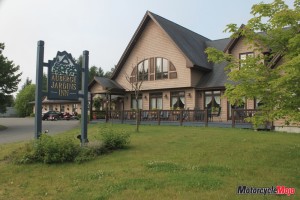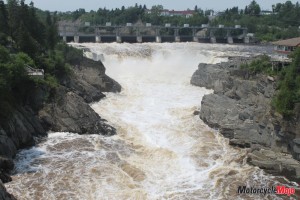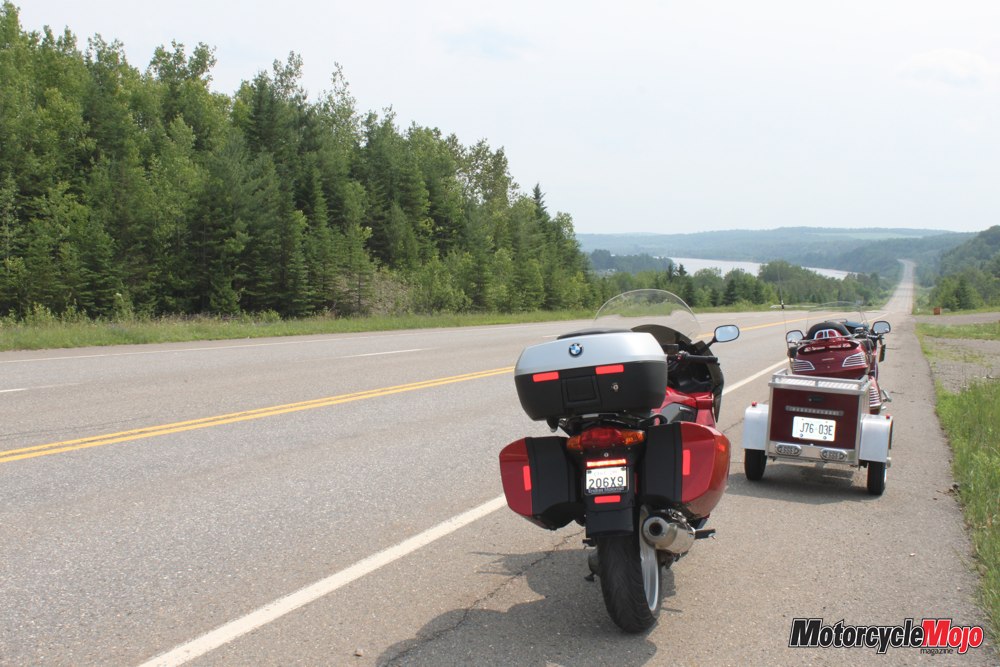Riding along the Saint John River Valley provides a history lesson of Bricklins and cymbals, a plethora of scenic views, and a few forgotten memories
High above Lac Pohénégamook, I steal careful glances across its deep blue waters in search of its scarcely seen monster, Ponik, but he is nowhere to be seen today. The legendary Ponik was first sighted in 1874 and there have been several sightings since, but much like Nessy and Bigfoot, Ponik is in the eyes and minds of its beholders.
Hank and I have come south from the St. Lawrence’s south shore on beautiful and remote Hwy 289, an alternative to the Trans-Canada. The northern Appalachians rise up, gleaming green from recent rains, and the creeks and rivers are filled to overflowing. We cruise past Lac Long, and shortly after, the highway changes to 120 as we cross over into Canada’s shining emerald jewel, New Brunswick. After Baker Lake, at Caron Brook we catch sight of the mighty St. John River. Cradled in the valley far below, just across its silt-laden, swirling eddies, we can see the state of Maine.
 As we follow the river, a multitude of verdant hues overpower our senses in this place, Canada’s greenest province. Soon we arrive in St. Jacques, just next door to Edmundston, where we find the lovely Les Jardins Inn, our digs for the first night of our adventure. From here, we will follow Canada’s Rhine all the way to the Bay of Fundy, using all the old Trans-Canada roads to get there.
As we follow the river, a multitude of verdant hues overpower our senses in this place, Canada’s greenest province. Soon we arrive in St. Jacques, just next door to Edmundston, where we find the lovely Les Jardins Inn, our digs for the first night of our adventure. From here, we will follow Canada’s Rhine all the way to the Bay of Fundy, using all the old Trans-Canada roads to get there.
We start July 1, Canada Day, with a short walk to the New Brunswick Auto Museum. Next to the front door sits New Brunswick’s lone entrant in the auto-manufacturing world, an original Bricklin. In 1974 and 1975, just under 3000 of these cars were produced by inventor Malcolm Bricklin. Many innovative features were built into this gull-winged beauty, including energy-absorbing bumpers, a steel roll cage and fibreglass-reinforced acrylic body panels that were stronger than steel.
Next door, the Botanical Garden makes a pleasant stop. After a tour, we enjoy some delicious local flavours: ployes (an Acadian buckwheat pancake) and fiddlehead soup. This is a fitting start to our tour along the St. John River corridor, also known as the River Valley Scenic Drive.
We mount up and ride across town, looking for Hwy 144, the old Trans-Canada Highway. Where the Madawaska and St. John Rivers meet, a log structure stands silhouetted high atop a granite outcrop. Because of a land conflict between the United States and Britain in 1841, Fortin du Petit- Sault was built. The Americans wanted this area for its tall white pines, which were used in shipbuilding. A year later, without a shot being fired, it was decided that the St. John River would be the boundary between territories.
 Highway 144 takes us southward, past farms that stretch along the shores of the river. At Grand Falls, the river plunges 23 metres downward through a narrow chasm. From the bridge, we spot the 150-metre zip-line cable hovering over the falls; Hank and I look at each other and in unison we say, “Nope.” Now on the west bank of the river, we catch Hwy 130, and with grand vistas of green rolling out before us, we continue south.
Highway 144 takes us southward, past farms that stretch along the shores of the river. At Grand Falls, the river plunges 23 metres downward through a narrow chasm. From the bridge, we spot the 150-metre zip-line cable hovering over the falls; Hank and I look at each other and in unison we say, “Nope.” Now on the west bank of the river, we catch Hwy 130, and with grand vistas of green rolling out before us, we continue south.
As we roll into Bath, I recall a time, 48 years ago, when young love took me on my first motorcycle trip, to visit one of New Brunswick’s fairest maidens. Out of curiosity, I brush the cobwebs of time from my head and gamely attempt to find the house where she once lived. Many things have changed in 48 years and my hunt meets with failure, but not before Hank loses patience with my constant U-turns and backtracking on gravel dead-end roads.
Along the river at Florenceville, we pass by the McCain Foods World Headquarters. Native Florenceville citizens Harrison and Wallace McCain created a food empire here, based on the modest potato. Their loyalty to their hometown is evident. We turn right into the Florenceville covered bridge and rumble across the river. Built in 1911, only one span is presently covered. The bridge was originally built in 1885, but that one was destroyed by fire. In 1911, the bridge was rebuilt with a covered section on each end; however, the west span was destroyed by fire again in 1932.
Even this far from its source, the river is still a swirling, threatening, brown eddy as it slowly drains the valley. Across the bridge, Hwy 103 takes us downstream to the elegant Tannaghtyn Inn. Built for one of the McCains, the house is now owned by Ruth and Ian Giberson, our semi-retired hosts. With a commanding view of the river and the hills beyond, I can hardly wait to see the magnificent sunrise. After we settle in, we head back into town to find a place to eat. Near the town bridge, we cautiously ride by a female moose grazing contentedly at the side of the road. Later, as I sit on the front steps of the inn, gazing across the river, I recollect fond memories of 1965, when I first arrived here on my little Honda Super Hawk. It is so peaceful and quiet that I can almost hear the river gurgling along, and as twilight fades, so do my ruminations.
Awake at 4:30 a.m., I quietly sneak out to set up my tripod for that miraculous sunrise. By the time I return, Ian has started coffee for us, and after a hearty breakfast, we tentatively wind down the long driveway. Centreville Road takes us to Potato World, a museum where we learn about everything potato. Cultivated by the Incas in Bolivia and Peru, potatoes were brought to Europe by Spanish explorers in the 1500s. As a member of the nightshade family, the potato was thought to be poisonous. Though the green parts are toxic, the tuber that grows beneath the ground has become a staple for many cultures today. Life was not easy for farmers in the early years, and the museum unveils New Brunswick’s tasty tale of the tuber. After a lunch, poutine of course, we thread our way south along Hwy 105 to the Hartland Bridge, the world’s longest wooden covered bridge.
At 1282 feet, the bridge was officially opened on July 4, 1901. In 1904, a sidewalk was added, and in 1922, the bridge was covered. In 1980, it was declared a National Historic Site, and the Olympic Torch was carried across it for the 1988 Winter Olympics. Just a few miles down the road at Meductic, population 270, we find the home of Sabian Cymbals. In 1618, alchemist Avedis Zildjian from Constantinople, Turkey, was trying to create gold, but instead created an alloy of tin, copper and silver that, when struck, would not crack but had unique sound qualities. Today, this family is still the world’s major producer of high-quality cymbals. A family dispute in 1979 caused a split. Robert Zildjian took over the Meductic plant, and in 1981 he founded Sabian Cymbals. Zildjian still produces cymbals in Massachusetts, but Sabian produces and sells approximately 1500 units per day, each one individually tested.
A tour of the plant unveils a family of workers who take great pride in their craftsmanship, as do many of the world’s greatest drummers. Neil Peart of Rush, Chad Smith of Red Hot Chili Peppers, and Phil Collins are just a few who use Sabian Cymbals. It is a phenomenal tour where we see the entire process, from ingot to finished shiny product. Following the river, we arrive at Nackawic, a logging town. Hank wonders what I want to see here, but follows my lead as I ride along a gravel pathway to see the World’s Largest Axe in a park behind the town arena. Will Ferguson, Canadian author and humorist, says in his book Canadian Pie that if your town isn’t especially significant, then build something that’s the “World’s Largest” and tourists will flock to your doorstep. Campbellton’s salmon, Wawa’s goose, and Shediac’s lobster are just a few examples.
Highway 105 meanders along the river, where fiddlehead signs indicate that we are still on the River Valley Scenic Drive. Fiddleheads are the curly beginnings of ferns and a popular edible wild plant in New Brunswick. Past Mactaquac Park we enter Fredericton, the provincial capital. My wife, Tina, has flown here to join us, and after meeting up, we book into our room at the Delta, right on the river’s edge. Brian, an old friend who took a log-building course with me many years ago, meets us and we spend an evening catching up before calling it a night. The next day starts at Café Sweet Belgian Desire on Charlotte Street, where we feast on a phenomenal breakfast of crepes smothered in fruit and whipped cream. Bellies full, we head over to the Historic Garrison District. Fredericton is home to Canada’s first army, and each day at 11:00 a.m. and 4:00 p.m., a “changing of the guard” ceremony takes place.
It is a colourful pageant with guns firing, smoke rising, and troops being inspected in their brilliant red uniforms. Leaving Fredericton on this, the last day of our river ride, we follow Hwy 102 through Oromocto. Far from its source, the river is now very blue, but our progress is soon halted by construction and the road is closed. We backtrack to the Burton Bridge and follow Hwy 105 on the other side of the river for 42 km to the tiny Jemseg ferry, where we cross over to Hwy 102 again. Not far from Queenstown, we round a bend and a scene fit for an artist’s canvas opens before us. We stop, spellbound, at the Elizabeth (Betty) Lacey scenic overlook.
Apparently, Betty Lacey was an active member of the Women’s Institute, and she lived near here in a home that overlooked the two islands in the river. A few miles ahead, a commanding view of Caton’s Island stops us. First inhabited by a crew member of Samuel de Champlain, it has been owned by various people and companies. Today, the Wesleyan Church uses it as a retreat. Regrettably, beautiful Hwy 102, the River Valley Scenic Drive, ends and Hwy 7 takes us to Hwy 1 and over Harbour Bridge and the Reversing Falls. Canada’s Rhine, aptly named because of its boating traffic, fades in the distance, and we arrive in Saint John. Our search for an evening repast takes us along King Street, the shortest, steepest, widest main street in Canada, and then up the steep Princess Street to Mexicali Rosa’s, where we dine and talk about tomorrow’s ride along the cliffs, high above the home of the world’s highest tides, the Bay of Fundy.



























